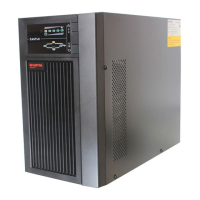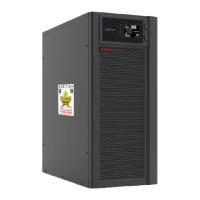What does BUS Under Voltage mean on Santak UPS?
- SSteven CampbellSep 8, 2025
The UPS get BUS under voltage fault. The UPS transfers to Bypass mode if supporting the load.
What does BUS Under Voltage mean on Santak UPS?
The UPS get BUS under voltage fault. The UPS transfers to Bypass mode if supporting the load.
Why is my Santak UPS in battery mode?
A utility failure has occurred, and the UPS is now powering your equipment with its battery.
What to do if Santak UPS battery is low?
The UPS is in Battery mode, and the battery is running low. Prepare your equipment for shutdown.
How to fix Santak CASTLE RACK 6K over temperature?
The UPS internal heat sink temperature is too high, or a fan has failed. Clear vents and remove any heat sources. Allow the UPS to cool.
Why does my Santak CASTLE RACK 6K UPS say no battery?
The batteries are disconnected. Verify that all batteries are properly connected.
What does Charger Fail mean on Santak CASTLE RACK 6K UPS?
Indicates that the UPS has confirmed the charger has failed. Contact your service representative.
What does BUS Short mean on Santak CASTLE RACK 6K UPS?
Indicates that the BUS voltage decrease very fast. Contact your service representative.
What does BUS Softstart Fail mean on Santak CASTLE RACK 6K?
Indicates that the BUS could not soft start successfully. Contact your service representative.
What does Inv Over Voltage mean on Santak UPS?
The UPS get invert over voltage fault. The UPS transfers to Bypass mode if supporting the load.
What to do if Santak CASTLE RACK 6K UPS shows fan failure?
The fan could not work normally. Check fans of UPS.
Lists relevant safety and EMC certification standards for the UPS.
Explains common symbols used for warnings and important information.
Discusses hazards related to voltage backfeed, qualified personnel, and battery handling.
Covers UPS connection, fire risk reduction, and circuit protection requirements.
Details precautions for handling, installation, and storage of the UPS unit.
Details eco-design approach, substances, and recycling of packing materials.
Explains how UPS protects equipment from power problems and lists UPS benefits.
Illustrates and labels the front panel components of the UPS.
Illustrates and labels the rear panel connections and ports.
Provides a block diagram of the UPS internal circuitry.
Instructions for checking for shipping damage before installation.
Guides on how to safely unpack the UPS unit, avoiding condensation.
Lists included accessories for UPS and EBM models.
Details rack mounting procedures for UPS and EBM units.
Explains how to connect AC power cables to the UPS terminal blocks.
Details connecting UPS terminal blocks to a PDU source.
Explains connecting multiple UPS units in parallel for shared power.
Describes the UPS LCD screen, buttons, and indicator light meanings.
Explains the various displays and information shown on the UPS LCD screen.
Details the functions of the ON/OFF and Test/Silence buttons.
Describes the various operating modes of the UPS and their display indicators.
Provides step-by-step instructions for starting and shutting down the UPS.
Explains how to configure UPS settings like ECO and CVCF modes via the LCD.
Details how to adjust the charging current for the UPS batteries.
Describes RS232, USB ports, and the Emergency Power Off (EPO) function.
Information on optional network cards for remote monitoring and control.
Introduction to the WinPower software for UPS monitoring and control.
Guidelines for keeping the UPS clean and operating at optimal temperature.
Instructions for safely disconnecting and preparing the UPS for transport.
Recommendations for long-term storage, including battery recharging.
Detailed safety precautions and steps for battery replacement.
Procedure for replacing the Extended Battery Modules (EBMs).
Guidance on proper disposal of UPS and batteries according to regulations.
Lists common UPS alarms, their causes, and recommended actions.
| Capacity | 6 kVA / 5.4 kW |
|---|---|
| Input Voltage | 220/230/240 VAC |
| Input Frequency | 40-70 Hz |
| Output Voltage | 220/230/240 VAC |
| Output Frequency | 50/60 Hz ± 0.1 Hz |
| Output Waveform | Pure Sine Wave |
| Operating Temperature | 0-40°C |
| Humidity | 0-95% non-condensing |
| Transfer Time | 0 ms |
| Battery Type | Sealed Lead Acid, Maintenance-free |
| Typical Recharge Time | 4 hours to 90% |
| Communication Interface | USB, RS232, SNMP (optional) |
| Form Factor | Rackmount |
| Efficiency | Up to 95% |
| Battery Backup Time | Depends on load |

